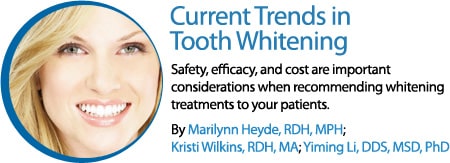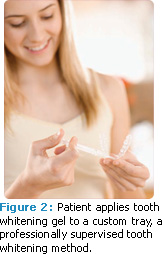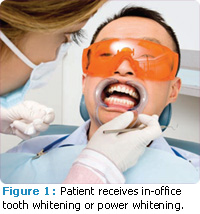
Current Trends in Tooth Whitening
Safety, efficacy, and cost are important considerations when recommending whitening treatments to your patients.
The desire for whiter teeth is nothing new. In 1848, dentists were whitening teeth with chloride of lime.1 Other bleaching agents were subsequently introduced, including aluminum chloride, oxalic acid, pyrozone, and sulphurous acid.2 In the early 1900s, the use of high-intensity light was combined with hydrogen peroxide to speed up the whitening process.3
Haywood and Heymann introduced nightguard vital bleaching (NGVB), which used carbamide peroxide as the primary active ingredient, for at-home whitening in 1989.4By the mid-1990s, tooth whitening was ubiquitous as celebrities showed off whiter and whiter teeth, and Americans began associating an attractive smile with physical health and wellbeing.5
Today, there are three main methods of tooth whitening: inoffice or power whitening (Figure 1); professionally supervised at-home whitening or tray bleaching (Figure 2); and over- the-counter (OTC) products. When considering which approach is most appropriate, safety, efficacy, and cost are all important variables.
Perspectives on Efficacy
Successful tooth whitening depends on two parameters: type or nature of the stain, and the material and method of bleaching. The prognosis depends on the color of the stain (gray is the most difficult color to bleach), and its location on the tooth. The gingival portion of the tooth is more challenging to whiten than the incisal portion, due to its thickness.6 Most teeth take 3 days to 6 weeks to whiten, dependent upon the individual’s tooth response versus the type of whitening method used. Each tooth has a maximum whiteness particular to individual dentition; patients can experience vastly different results with the same product.7
For some stains, the contact time of the bleaching gel to teeth determines efficacy, although the peroxide concentration of the gel also makes a difference. Peroxide goes through the enamel and dentin, reaching the pulp in 5 minutes to 15 minutes. One theory suggests that peroxide’s free radicals break down macromolecules of stain into smaller molecules and/or alter the configuration of the molecules, which changes the perception of the dentinal and enamel color.8
The long-term safety of tray whitening using 10% carbamide peroxide has been established by a large number of laboratory, animal, and clinical studies.9 Enamel is not significantly affected by proper use of reputable whitening gels, though adverse effects on the dentin have been reported.10 A review of the literature concludes that 10% carbamide peroxide is safe to use after a proper dental examination. Free radicals of peroxides can interact with DNA, and thus concerns about the carcinogenicity and co-carcinogenicity of hydrogen peroxide have been raised. But there has been no evidence of cancer risk associated with tooth whitening.11
Comparison of the Three Main Methods
In-office or power whitening systems use high levels of hydrogen peroxide—between 15% and 40%. Advantages are patient compliance and immediate visible results. The potential disadvantages are the cost and increased risk of dentinal hypersensitivity. In-office treatments may or may not yield the same outcome as tray bleaching systems. In-office procedures that are followed by at-home tray bleaching can provide patients with satisfactory results.12 This approach helps resolve the color relapse that often occurs 1 week or 2 weeks following in-office procedures.13 The best time to evaluate the success of in-office bleaching is after the shade has stabilized— approximately 2 weeks to 6 weeks after treatment.
Tray bleaching uses gels that contain 10% to 35% carbamide peroxide or 2% to 10% hydrogen peroxide, and is significantly less expensive than in-office whitening.5 The main disadvantage is patient compliance. In addition, the recent trend of increasing the peroxide content of whitening gels used in tray systems is concerning because higher peroxide concentrations can have negative effects.
OTC whitening products commonly use 3% to 10% hydrogen peroxide as the active ingredient. These products come in a variety of forms including strips, wraps, trays, and paint-ons. Some significantly whiten teeth, while others do not make a clinical difference in tooth color.14
The main advantages of OTC products are cost and accessibility. The major disadvantage is that whitening teeth without a concurrent dental examination may camouflage serious, undiagnosed dental problems that require attention. In Europe, OTC-type whitening products can be purchased only with a prescription and after examination by a dental professional. This ensures that tooth whitening does not mask signs of pathology (eg, teeth darkened from abscesses, decay, or resorption).15
A vital or nonvital tooth may darken due to trauma, resulting in hemorrhage into the dentinal tubules. Other common causes for vital and nonvital tooth discoloration include internal or external resorption, calcific metamorphosis or pulp canal obliteration, decay, or leaking restorations on the proximal or lingual surfaces. Once it is determined that a tooth is vital or nonvital, different bleaching modalities are available to treat the single dark tooth.
Tooth whitening may adversely affect restorations. Studies report a decrease in bond strength up to 28% when a composite restoration is bonded immediately after the completion of a bleaching procedure; bond strength returns if a waiting period of 14 days is observed.16
Dentinal Hypersensitivity
Dentinal hypersensitivity is experienced by 25% to 75% of patients undergoing tray bleaching, and 10% to 90% of those receiving in-office whitening procedures.17 Browning and Swift found that the higher the concentration of bleaching product, the greater the incidence of sensitivity.18 Fugaro and coworkers reported mild, reversible histological changes in the pulp when 10% carbamide peroxide was used in a bleaching tray overnight.19 The majority of dentinal hypersensitivity, however, subsides within a day or two of stopping whitening treatment. In most cases, sensitivity peaks on day three or four of treatment and then dissipates over time.
Dentinal hypersensitivity is the most common reason patients discontinue any type of whitening treatment.20 There are two main approaches to control bleaching sensitivity: passive treatment, which includes reducing the wear time and/or increasing the time between bleaching episodes; and active treatment, which includes brushing with desensitizing toothpaste for 2 weeks before beginning tooth whitening, as well as placing desensitizing agents in the bleaching trays for 10 minutes to 30 minutes before or after each bleaching session. The addition of potassium nitrate or a calcium phosphate technology—such as amorphous calcium phosphate, casein phosphopeptide-amorphous calcium phosphate (Recaldent®), calcium sodium phosphosilicate (NovaMin®), and tricalcium phosphate—to bleaching materials may also reduce sensitivity. The new Pro-Argin™ technology—which includes a combination of arginine, an amino acid found in saliva, and calcium carbonate—also reduces dentinal hypersensitivity and is available in a paste applied chairside and in an OTC dentifrice.
Strategies for Challenging Cases
A patient may present with a specific challenge, such as white spots, dark spots, mottling, or tetracycline stains. These situations can be addressed, but patient expectations must be effectively managed because final results are not predictable.
White spots do not bleach, but they may become less noticeable if the surrounding tooth structure color is lightened to reduce the contrast. White spots may go through a splotchy stage during bleaching, but this usually disappears. Whitening should be continued until the base color of the tooth reaches its maximum lightness.21 If the white spot surface is not fluoride-rich or glazed, a calcium phosphate technology may help remineralize the lesion, effectively reducing the white spot’s opacity.22
Brown discoloration usually responds differently than white spots. This type of discoloration is very responsive to bleaching and is successful approximately 80% of the time.23 Brown discoloration may be caused by minocycline or other drug use. Patients who take minocycline (often prescribed for acne treatment) for long periods should be cautioned about the risks of tooth staining.
One of the most difficult tooth stains to bleach is caused by the antibiotic tetracycline. These stains can be lightened most of the time; however, it may take 1 month to 12 months of nightly bleaching using a gel of 10% carbamide peroxide. Nicotinestained teeth also take longer to bleach, requiring from 1 month to 3 months of nightly bleaching using 10% carbamide peroxide. Successful bleaching of difficult cases can be achieved with careful planning, custom treatment regimens, and ade quate monitoring of the bleaching progress.24
Summary
Tooth whitening has become an accepted and popular esthetic dentistry procedure. Research over the past 20 years has indicated no significant, long-term oral or systemic health risks when professional-assisted at-home tooth bleaching with materials containing 10% carbamide peroxide is used. Tooth bleaching does involve risks, however, such as dentinal hypersensitivity and gingival irritation. Most cases are mild to moderate, transient, and reversible. When gels containing higher hydrogen peroxide concentrations are used without adequate gingival protection, severe mucosal damage can occur.
Effective, predictable, and safe tooth whitening is possible, but it requires an accurate diagnosis of the causes of tooth discoloration or stains. Therefore, dental professionals should be involved in all tooth bleaching processes to ensure safety and efficacy.
REFERENCES
- Dwinelle WW. Ninth Annual Meeting of American Society of Dental Surgeons. Article X. Am J Dent Sci. 1850;1:57–61.
- Haywood VB. History, safety and effectiveness of current bleaching techniques and application of the night guard vital bleaching technique. Quintessence Int. 1992;27:471–488.
- Greenwall L. Bleaching Techniques in Restorative Dentistry. London: Martin Dunitz; 2001.
- Haywood VB, Heymann HO. Nightguard vital bleaching. Quintessence Int. 1989;20: 173–176.
- Lupovici EM. Making the wish for a whiter smile come true. Dimensions of Dental Hygiene. 2008;6(3):24–26
- Leonard RH Jr, Haywood VB, Caplan CJ, Tart ND. Nightguard vital bleaching of tetracycline-stained teeth: 90 months of post treatment. J Esthet Restor Dent. 2003;15:142–153.
- Matis BA. Tray whitening: what the evidence shows. Compend Cont Educ Dent. 2003; 24:354–362.
- McCaslin AJ, Haywood VB, Potter BJ, Dickinson GL, Russell CM. Assessing dentin color changes from nightguard vital bleaching. J Am Dent Assoc. 1999;130:1485–1490.
- Leonard RH Jr. Efficacy, longevity, side effects, and patient perceptions of nightguard vital bleaching. Compend Cont Educ Dent. 1998;19:766–774.
- De Oliveria OP, Teixerira ECN, Ferraz CCR, Teixerira FB. Effect of Intracoronal bleaching agents on dentin microhardness. J Endod. 2007;33:456–462.
- Li Y. Safety controversies in tooth bleaching. In: Diagnosis and Treatment of the Most Common Esthetic Needs. Calamia JR, Wolff MS, eds. Dent Clin N Am. 2011;55:255–263.
- Haywood VB. Tooth Whitening: Indications and Outcomes of Nightguard Vital Bleaching. Hanover Park, Ill: Quintessence Publishing Co Inc; 2007.
- Blankenau R, Goldstein RE, Haywood VB. The current status of vital tooth whitening techniques. Compend Cont Educ Dent. 1999;20:781–796.
- Zanter C, Derdilopoulou F, Martus P, Kielbassa AM. Randomized clinical trial on the efficacy of two over-the-counter whitening systems. Quintessence Int. 2006:695–706.
- American Dental Association Council on Scientific Affairs. Tooth Whitening/Bleaching: Treatment Considerations for Dentists and Their Patients. Available at: www.ada.org/sections/about/pdfs/HOD_ whitening_rpt.pdf. Accessed October 27, 2011.
- Comlekoglu ME, Gokce B, Kaya AD, Turkun M, Ozpinar B. Reversal of reduced bond strength after bleaching. Gen Dent. 2010;58:258–263.
- Haywood VB. Dentine hypersensitivity: bleaching and restorative considerations for successful management. Int Dent J. 2002;52:376–384.
- Browning WD, Swift EJ Jr. Critical appraisal: power bleaching. J Esthet Restor Dent. 2011;23:61–67.
- Fugaro JO, Nordahl I, Fugaro OJ, Matis BA, Mjör IA. Pulp reaction to vital bleaching. Oper Dent. 2004;29:363–368.
- Haywood VB. Treating sensitivity during tooth whitening. Compend Contin Educ Dent. 2006;26(Suppl):11–20.
- Haywood VB. The “bottom line” on bleaching. Inside Dentistry. 2009;4(2):82–89.
- Ardu S, Castioni NV, Benbachir N, Krejei I. Minimally invasive treatment of white spot enamel lesions. Quintessence Int. 2007;38:633–636.
- Croll TE, Cavanaugh RR. Enamel color modification by controlled hydrochloric acid pumice abrasion. I. Technique and examples. Quintessence Int. 1986;17:81–87.
- Li Y. Commentary. Successful bleaching of teeth with dentinogenesis imperfecta discoloration: a case report. J Esthet Restor Dent. 2011;23:11.
From Dimensions of Dental Hygiene. November 2011; 9(11): 36, 38, 41-42.


